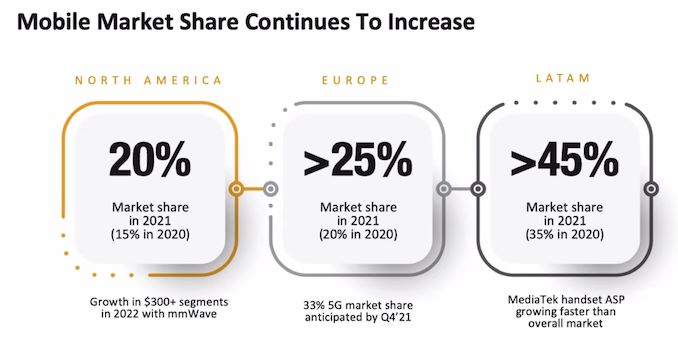MediaTek Announces Dimensity 9000: Supercharged Flagship SoC on 4nm
by Andrei Frumusanu on November 18, 2021 6:00 PM ESTConclusion & First Impressions
MediaTek’s re-entry in the flagship SoC space with the Dimensity 9000 comes at quite the opportunistic time in the landscape. The company has had a very successful 2021 with large market share gains, and we’ve even seen this translate into more exposure in more visible design wins in the market, such as the OnePlus Nord 2 series or the Xiaomi 11T.
Having seen large market share gains and being able to fill in a huge gap in the market where Huawei and HiSilicon were in the past, the Dimensity 9000 seems to have come at the perfect time, as more vendors want to be able to differentiate their highest end devices and diversify their reliance on Qualcomm’s Snapdragon series.
The Dimensity 9000, on paper, and by the specification, looks like an extremely strong SoC for 2022 flagships. On the CPU side of things, MediaTek has fully equipped the SoC with near the maximum possible configuration – high frequencies, large caches, and surprisingly enough for us today, a full performance configuration of the new Cortex-A510 cores. The 8MB L3 is helped by a new 6MB system cache that further improves memory performance, which the Dimensity 9000 of is currently the first and only chip to support new LPDDR5X.
The GPU side, the chip likely will be the only design for 2022 with a large Mali GPU. Advertised performance figures are good, but what matters most is power efficiency and sustained performance. While the metrics here are still a bit vague, the N4 process node of the chip, again, the first of its kind, is likely to position the chip in an excellently against 2021 devices, and if Qualcomm and Samsung don’t have major leaps in their upcoming designs, also position the Dimensity 9000 extremely well against the 2022 competition.
MediaTek’s camera and ISP leaps are also just huge. We haven’t really had many camera-centric phones powered by MediaTek silicon over the last few years, so if vendors are able to take advantage of the chip’s new camera architecture remains to be seen, but at least the high-level specifications are definitely worthy of 2022 flagships.
The chip’s lack of mmWave is likely limit its success to non-US markets and devices, but that’s a situation we generally become used to over the years.
The Dimensity 9000 is MediaTek’s strongest showing in years, and has the specifications and heft to properly shake up the high-end market. I see it competing against, or even besting whatever Qualcomm has in queue for next year, which is a pretty shocking turn of events. What matters now, is for MediaTek to actually have the high-profile flagship device design wins, to be able to fully rationalise their investment in such a SoC. Luckily, we’ve been told the chip has already sampled to customers, and we’re to expect commercial device launches in the first quarter of 2022. Exciting times are ahead in the mobile SoC space.












150 Comments
View All Comments
mode_13h - Tuesday, November 23, 2021 - link
> It’s closer to what the Japanese were forty years ago.The exception I take with this is that Japan's system of government is decidedly democratic and somewhat decentralized. In China, there's too much concentration of power, leaving no obvious pathway towards reform.
TheinsanegamerN - Friday, November 19, 2021 - link
China isnt communist just like soviet russia wasnt communist, because *Real Communism has never been tried, right?Oxford Guy - Friday, November 19, 2021 - link
Howard Zinn’s description of the Arawak people is an example of actual communism. The Amish are a close approximation also. Many societies have been strongly communistic throughout history. They are generally not belligerent and die out. The Arawaks were slaughtered by aggressive Europeans and the Amish will eventually find their land confiscated as US population expands and the resulting sprawl overtakes what’s left of their area.The more important dichotomy seems to be aggressive expansionism versus peaceful inwardness — what the expansionists call backwardness.
mode_13h - Saturday, November 20, 2021 - link
> the Amish will eventually find their land confiscated as US population> expands and the resulting sprawl overtakes what’s left of their area.
The Amish have a very high birth rate, for fairly obvious reasons. I think they're probably "sprawling" much faster than the cities around them. And since they have legal ownership of their land, it's not clear how it would be "confiscated".
Oxford Guy - Saturday, November 20, 2021 - link
Law changes with convenience and I suppose you’ve not heard of eminent domain.mode_13h - Sunday, November 21, 2021 - link
> I suppose you’ve not heard of eminent domain.Of course I have. It's no longer used much, in the US. Furthermore, it's subject to legal challenge and has to withstand the test of an overwhelming public interest.
Do you even live in the USA? It seems like you don't know as much about it as you think.
mode_13h - Sunday, November 21, 2021 - link
That's not to imply that plenty of people living here don't know even less about it. However, it helps to live in a place, if you're to really understand how such things as its legal system function.Oxford Guy - Sunday, November 21, 2021 - link
‘It's no longer used much, in the US.’Haha.
melgross - Monday, November 22, 2021 - link
It’s very rare. And it can. E fought in court. It’s hard to see any way their property could be taken by the state using it.Oxford Guy - Monday, November 22, 2021 - link
‘It’s very rare. And it can. E fought in court. It’s hard to see any way their property could be taken by the state using it.’Rarity is irrelevant. It only takes one success.
Have a chat with the people who have lost in court, such as the guy who tried to use eminent domain to take justice Breyer’s huge property. Yeah, one loses in court when one takes on a Supreme Court justice.